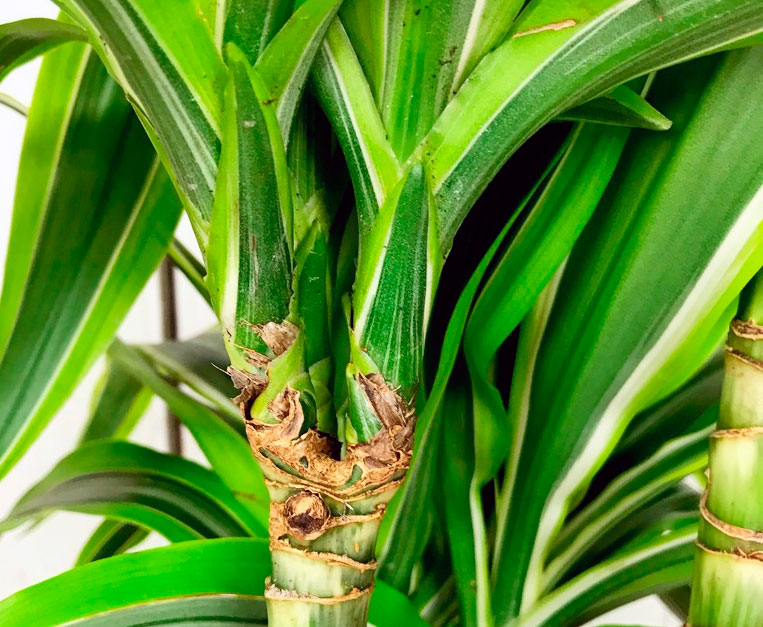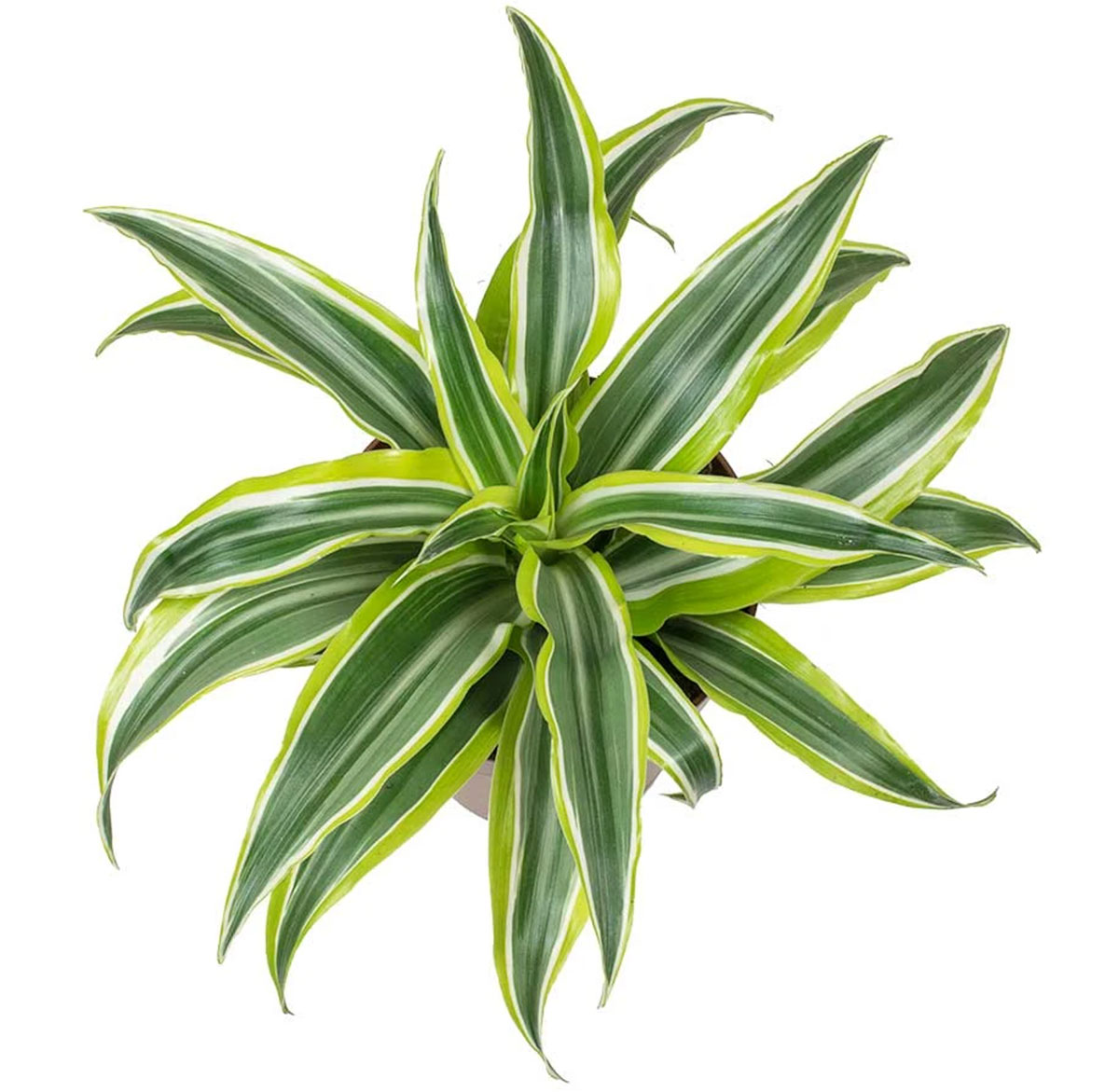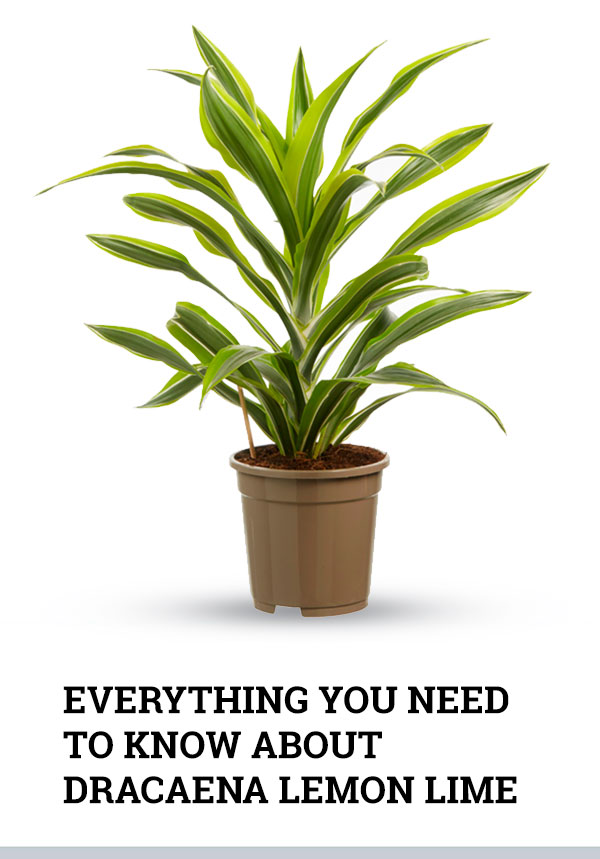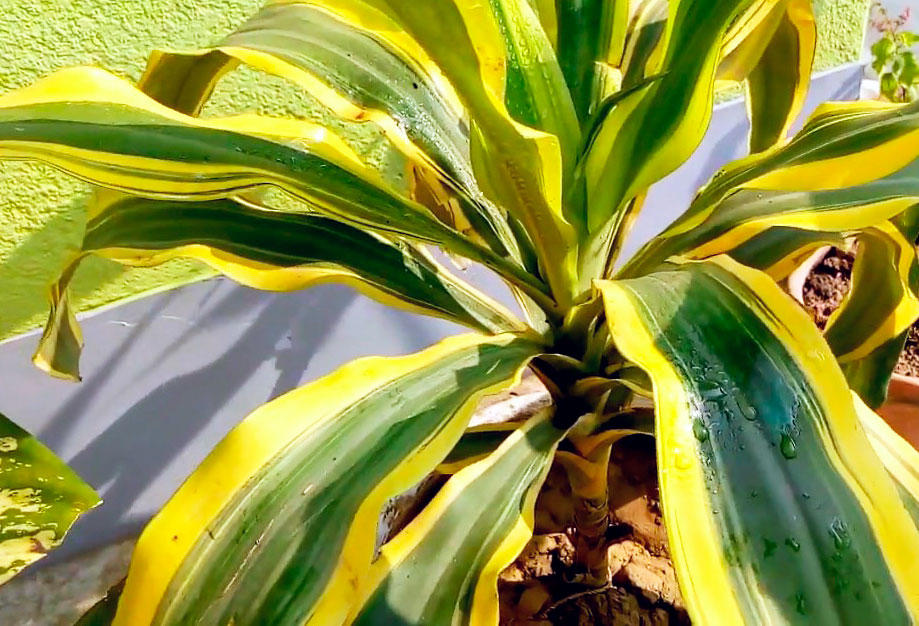When you know what to plant next to this or...
Dracaena Lemon Lime Plant Care Guide
Dracaena Lemon Lime is the plant of the asparagus family. Outwardly, it distantly resembles a palm tree due to the location and shape of the leaves, but these plants are not related. Dracaena Lemon Lime is bright, it will decorate any room, but in order to preserve the decorative qualities of the plant, it is necessary to provide it with suitable conditions.
✔ We Released The Dracaena HandBook
CLICK HERE TO LEARN MORE >>
Dracaena Lemon Lime is a kind of Dracaena Fragrans. Its main difference from the rest of the genus is bright leaves with yellow stripes. At home, you can grow Dracaena Lemon Lime 60-90 cm high. Rare specimens reach 2 m in height. At the same time, the plant develops for a long time - within 10 years.
Since this dracaena type belongs to shrubs, its trunk is branched, due to which the crown looks more lush.
The plant grows by 30 cm per year, so lemon lime is a slow-growing species. The crown of the plant is large - it reaches 40-61 cm in diameter, which depends on the age of the plant. The leaves in the center are saturated green with white lines, along the edges there is a wide edging of bright yellow color, due to which the flower got its name.
Advantages and Disadvantages of Growing Dracaena Lemon Lime
Many gardeners prefer to grow a spectacular variegated Dracaena Lemon Lime.
The advantages of growing Dracaena Lemon Lime are:
- Excellent decorative properties (Lemon Lime surpasses most other species of this family in attractiveness)
- Uncomplicated care
- High speed of plant adaptation
- Propagation does not require much experience, repotting is easy too
There are also disadvantages:
- Slow growth
- Lack of flowers when grown indoors
- Low height

Dracaena Lemon Lime: Plant Care Guide
Dracaena Lemon Lime is one of the most popular varieties of Dracaena Fragrans. The plant is well adapted to indoor conditions, suitable for homes, offices, and public spaces.
The height when grown indoors is usually 60‒90 cm, in rare specimens 150‒300 cm. The plant will need 5-10 years to reach the maximum height.
The typical form of Dracaena Lemon Lime growth is a branched shrub. The older Dracaena Lemon Lime is, the more it branches. Over the years, the straight evergreen trunk becomes bare and stiff. As a result, the plant takes on the appearance of a false palm.
To preserve the brightness of color and a healthy appearance, provide the plant with proper care: maintain the temperature and humidity at the proper level and regulate the intensity of light. If these conditions are not met, the crown will have a sloppy shape and the growth of the dracaena may slow down even more.
Dracaena Lemon Lime occasionally blooms with small white flowers, collected in racemose inflorescences. Like other varieties of Dracaena Fragrans, the flowers exude a characteristic strong aroma.

Care after purchase
After the purchase, bring Dracaena Lemon Lime home, while taking into account the air temperature outside, since dracaena is a tropical plant and does not tolerate cold weather. To prevent hypothermia of the plant, cover it with thick paper and a plastic bag. These materials will help keep warm inside the package. When the temperature drops to +10 °C or more, it is recommended to use a thermal bag.
You need to observe the plant for 2 weeks. During this period, dracaena adapts to new conditions. Then repot it into a larger container. The substrate that is usually contained in the pots in the store is not suitable for the good growth of the shrub; replace it with fertile soil.

Lighting
Dracaena Lemon Lime should be placed on the windowsill only if the windows face the north side. In other cases, you need to place the plant on the floor or on a stand near the window opening.
This will protect the shrub from direct sunlight on the crown, otherwise the plant will get sunburn. The latter looks like white spots. The recommended distance from windows facing south or east is 1-2 m.
In an insufficiently lit place, the leaves of Dracaena Lemon Lime lose their brightness. This leads to a decrease in the decorative qualities of the flower. However, the pathological process is reversible: it is enough to put the pot on a bright area of the room, and after a few days the plant's appearance will improve.
Temperature
A cool microclimate is not suitable for the plant. A temperature from +16°С to +27°С is perfect for Dracaena Lemon Lime.
In summer and winter, different conditions should be provided for dracaena. So, in the period from March to November, the temperature should be maintained at a level from +25°C to +27°С. In winter, the temperature should be from +16°С to +18°С.

Humidity
The higher this figure, the better for Dracaena Lemon Lime it is, because dracaena comes from tropical and subtropical latitudes. But if the plant is constantly located in a room where the humidity is about 90% or more, there is a risk of rot and mold.
A perfect humidity for Dracaena Lemon Lime is 40-80%. The flower can grow in harsher conditions (with a reduced level of humidity), but then it is necessary to regularly spray the green mass with warm water and wipe the leaves from dust once every 14 days.
Watering and feeding
It is enough to water Dracaena Lemon Lime once a week. You should also pay attention to the degree of dryness of the soil. Watering should be done before cracks appear in the soil. After watering immediately remove excess water from the pallet.
The frequency of Dracaena Lemon Lime watering also varies depending on the season. In the summer, you need to water the plant more often - 2 times a week. During the dormant period (in winter), the plant does not need a large amount of moisture, since at this time all intracellular processes are inhibited.
Dracaena Lemon Lime should be fed with special fertilizers for succulents and palms. The frequency of feeding in summer is once a week, in winter - once a month.
Repotting
Repotting should be done in March, when the period of active plant growth begins. After purchase, dracaena should be repotted within the first weeks no matter what season it is. Do not leave the plant in the pot from the shop, since the substrate in it is not suitable for good growth of dracaena.
The next time the flower must be repotted when the root system filles all the pot. This happens every 2-3 years (if the plant is mature) or annually (if the plant is young). Choose the pot that is 2-3 cm larger than the previous one.
At the bottom of the pot put drainage, the function of which is performed by expanded clay or sand. You should purchase a pot with a pallet and a perforated bottom - this will allow you to organize the removal of excess moisture.
Before repotting Dracaena Lemon Lime, water the plant (1-2 days before the procedure). Then remove the soil from the pot, carefully check the roots for rot and if there is some - remove it. Place the plant in the center of the new pot. There should be drainage and a layer of soil under it. At the last stage, fill the pot with new soil.
The soil should be loose, light and nutritious, neutral or slightly acidic. If necessary, you can use a commercially available universal or palm substrate.
Flowering
The flowers of Dracaena Lemon Lime are white and small in size. They form inflorescences. But at home, Dracaena Lemon Lime hardly blooms. This is due to the difference in environmental conditions. In rare cases, flowers still appear on Dracaena Lemon Lime when planted indoors, but only on plants in the greenhouse.
However, the buds form on plants no more than 1 time in 7-10 years, and the life span of the dracaena is not much longer than this period (15 years), so you may not see the inflorescences again.
Poisonous
Remember that Dracaena Fragrans is toxic to both cats and dogs. Do not allow your pets chew the leaves of the plant. It can cause weakness, vomiting and indigestion. At the first signs of poisoning, immediately bring your pet to a veterinarian. See more about pets and the effect toxins have here at the ASPCA.
How to propagate Dracaena Lemon Lime

There are 2 methods of Dracaena Lemon Lime propagation: apical and stem cuttings. In the future, shoots cut off during the formation of the crown (from the top of the shrub or part of the trunk) are used for plant propagation.
To propagate Dracaena Lemon Lime use cuttings up to 30 cm long. First, immerse them in water, and after a few days the roots will appear. Then plant the cuttings in soil, the composition of which is: peat and sand in a 1: 1 ratio.
Diseases and pests of Dracaena Lemon Lime

Under unsuitable conditions, Dracaena Lemon Lime will quickly begin to lose its decorative effect. If the shrub is adult, it is better not to neglect the care tips so as not to lose the beauty and splendor that have been formed over the years.
If the recommendations for care are violated and due to the development of pathological processes, the appearance of dracaena deteriorates:
- Pigmentation on the leaves appears due to lack of moisture
- Yellowing of the crown in the upper part of the plant indicates a violation of watering regime
- Dry leaf edges is the result of exposure to drafts
- Deformation of the leaves (if they twist) usually happens because of low air temperature
- White spots is a burn due to exposure to direct sunlight
- Brown plaques on the leaves is the result of damage to the plant by the scale insects
- Leaf color changes from green to gray in the result of thrips attack
- White dots, brown spots, cobweb are signs of spider mite infection

Features of growing varieties of Dracaena Lemon Lime
Prepare for Dracaena Lemon Lime a well-lit area of southwest or southeast orientation. With a lack of sunlight, its variegated foliage quickly loses its decorative properties.
In addition to a slightly acidic soil with a pH of 5.0‒6.0, which is optimal for Dracena, a neutral soil with a pH of 6.0‒7.0 is suitable for Lemon Lime. The soil should be nutritious and loose. Drainage is required.
When the duration of daylight hours in the autumn-winter period reduces, the plant needs an artificial rest period. Put it into a "dormant" state by smoothly lowering the temperature by +5°C +7°C, reducing watering to a possible minimum and canceling feeding.
In gratitude for the efforts made, Dracaena Lemon Lime will become a spectacular and bright highlight of any garden collection.
To the commonest of dracaena types belong:
- Snake Plant
- Marginata
- Sanderiana
- Reflexa
- Fragrans
- Janet Craig
- Warneckii
- Massangeana
- Compacta
- Deremensis
- Draco (Dragon Tree)
About the Author
My name is Michael Bauer, I have been growing and taking care of plants for 20 years. My dream has become a reality. I've had many difficulties along the way, but my love for our favorite plants has really helped me.So join us!

















